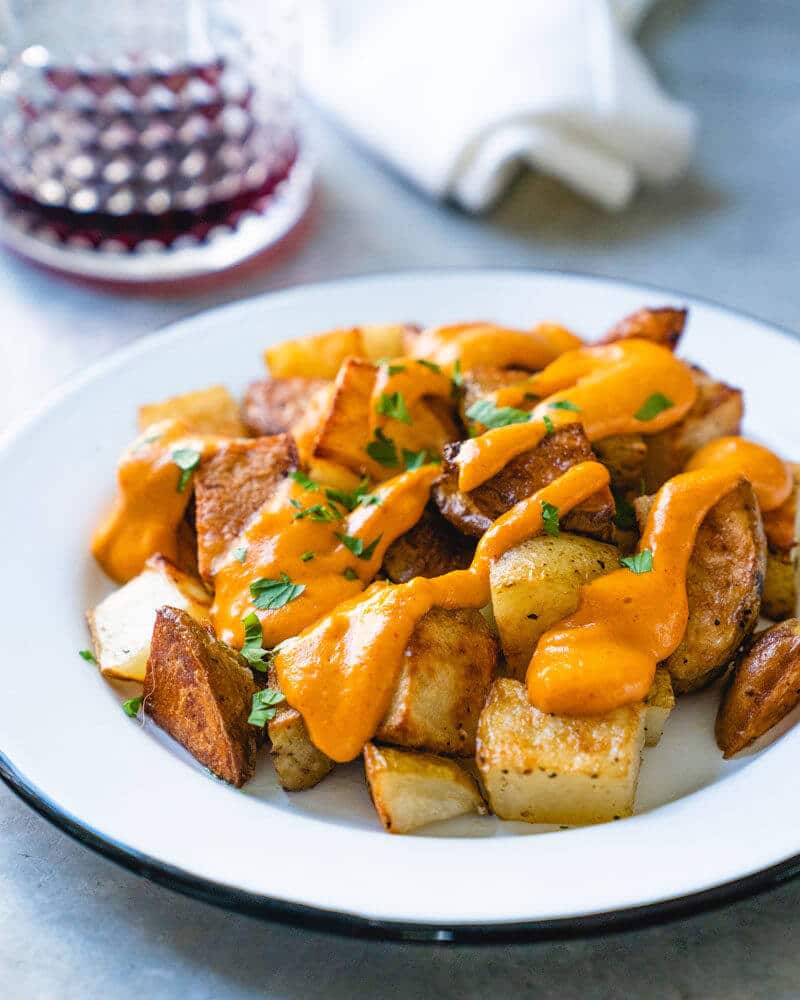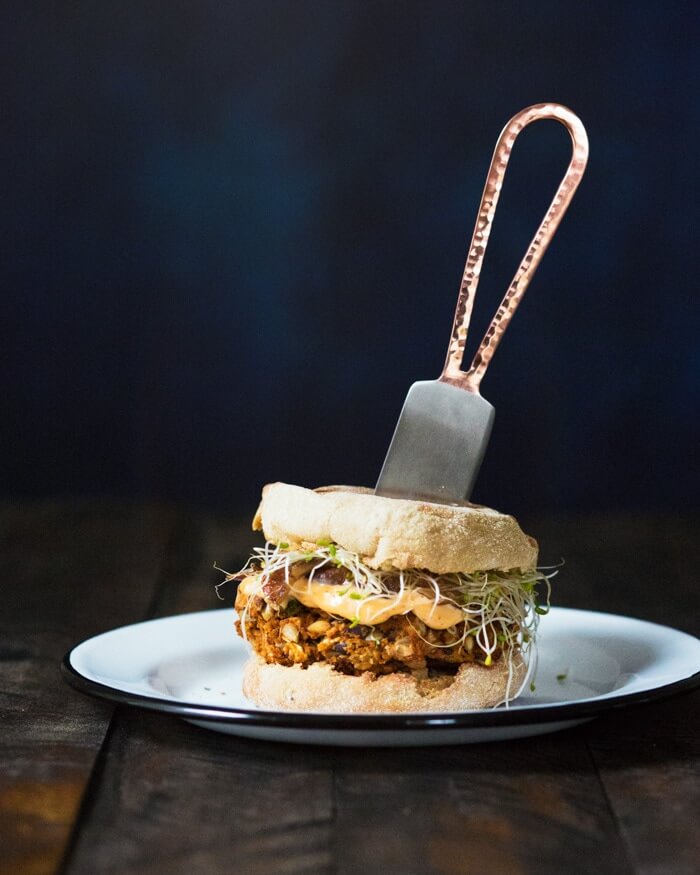This post may include affiliate links; for details, see our disclosure policy.
Smoked paprika deserves a spot in any spice drawer; it has an irresistible subtle smoky flavor. Here are the best smoked paprika recipes for using up a jar!

Got your hands on some smoked paprika? Because get ready, you’ve got so many delicious recipes in store! Alex and I have been cooking with smoked paprika for years, ever since I lived abroad in Spain (it’s essential in Spanish cooking). It’s got a subtle smoky flavor, and adds a hearty meatiness to vegetarian and plant based recipes. It’s such a versatile spice that we think smoked paprika deserves a spot in all spice cabinets around the globe!
Looking for smoked paprika recipes to use up a jar of it? You’ve come to the right place. Here are all the most delicious ways to use it, from Spanish roasted potatoes to paella to romesco sauce! Ready to get cooking?
What is smoked paprika?
But first, what is smoked paprika? It’s similar to the more common Hungarian sweet paprika, but it’s Spanish in origin. It’s made up of dried pimiento peppers that that are smoked over a fire, then ground. Here’s something important to note:
- Smoked paprika may be labeled as any of the following: pimentón, Spanish smoked paprika or sweet smoked paprika.
- Avoid hot smoked paprika! It’s too spicy and not interchangeable.
- Avoid sweet paprika or Hungarian paprika! It’s not smoky.
Where to buy smoked paprika?
You can find smoked paprika in the spice aisle in most grocery stores. Refer to the terminology above when you’re looking for it. You can also buy it online here!
And now…the best smoked paprika recipes!
The ultimate smoked paprika recipe: paella! This traditional Spanish rice dish is actually easy to make at home: we promise! You don't even need a fancy pan: a large skillet will do! Smoked paprika adds an earthy flair to the rice, which is topped with veggies, artichokes and shrimp. It's a stunning recipe for entertaining, but easy enough for a weeknight.
Also try: Easy Shrimp Paella or Vegetarian Paella
Patatas bravas are traditional Spanish tapas: fried potatoes with a warm sauce. Here's a version you can make at home! Here the potatoes are baked until crispy, instead of fried. They're topped with a creamy aioli sauce mixed with smoked paprika for a smoky flair!
Here's one of our favorite smoked paprika recipes: Smoky Ranch Dressing. That's right: it's homemade ranch dressing, made smoky by adding a bit of smoked paprika! Drizzle it over an iceberg wedge and top with chives, sundried tomatoes, blue cheese and crushed potato chips, and it's heavenly.
Romesco sauce is another traditional smoked paprika recipe! Romesco is a Spanish sauce made with jarred red peppers, garlic, olive oil, and almonds. It often has smoked paprika for a smoky undertone, as does this one. You can blend it up in just 5 minutes! Serve it with gnocchi for a super-fast meal.
Smoked paprika is a great way to add meatiness to vegetarian and plant based recipes. Here it is adding a meaty undertone in this black bean burger! Made with sweet potato and black beans, top it with spicy mayo for a hearty meal.
Speaking of meaty, this smoked paprika recipe also uses the smoky quality of the spice to evoke the idea of meat. Though these vegetarian meatballs are made of chickpeas and veggies, they're seriously satisfying! Especially doused in vegetarian gravy.
Smoked paprika also adds savoriness in this smoky lentil tacos recipe, where lentils and rice stand in as taco meat! Adding the pimenton brings in the perfect meaty element. Throw it into a tortilla and garnish with veggies and salsa for a tasty meal!
Here's a seriously incredible recipe using smoked paprika that's the best shrimp and grits you'll make in your home kitchen! This Southern classic traditionally uses bacon, but voila: with the magic of smoked paprika there's no need! A touch of the spice adds a smoky undertone that's seriously tasty.
Here's a smoked paprika recipe where you wouldn't even know it's there! These tacos are a unique fusion of Crispy Breaded Cauliflower, covered in our savory Yum Yum Sauce. The textures and flavors are so satisfying, this one's a big fan favorite. The smoked paprika is hiding in the cauliflower, giving it savory, salty, sweet and smoky flavors all at once.
Got a bit of smoked paprika to use up? Add it to deviled eggs! It adds just the right savory smokiness. Use it as a garnish on our Easy Deviled Eggs, or try these smoky deviled eggs topped with crispy shallots.
You've got to try this one to believe it. Yes, jackfruit can stand in as vegan pulled pork: and it's damn good! Here it's smothered in a homemade bourbon BBQ sauce that uses smoked paprika as a smoky element. After tasting it, we’re 99.9% sure you’ll also be on the jackfruit BBQ train, too.
Ever made your own seasoning salt blend? It's kind of like Lawry's seasoning salt, but you can make it at home! This recipe uses smoked paprika to add a nuanced, smoky element. It’s a fun kitchen DIY and perfect on grilled fish, veggies, and more.
Another way to make a smoked paprika recipe: throw it into soup! Since corn chowder often is made with bacon, for this vegan spin on it we used smoked paprika for a back-end smokiness. It's so seriously good: you'll never know it's plant based!
This refried bean dip is seriously flavorful: without the traditional cheese! Often bean dips are gooey and cheesy (here's our favorite cheesy bean dip). But why not try a healthy spin? This bean dip has lots of flavor from green chilis and cumin, and a smoky undertone from smoked paprika.
Ever had biscuits and gravy...without the meat? This recipe uses smoked paprika to make one seriously savory, mushroom country gravy. It's so thick and creamy and the biscuits are so impossibly flaky, it's hard to believe they're vegan.
It's not often that you'll find smoked paprika in an Italian soup recipe! But this one is unique. We've dubbed it our "pizza soup" recipe because it tastes like liquid pizza from the tangy tomatoes and Italian spices. Smoked paprika adds just the right savory undertone.
Yes, a homemade BBQ sauce is perfect with a little smoked paprika! This sauce is sweet and smoky, sweet from maple syrup and smoky from the paprika. Add a little vinegary tang and it's a go-to recipe for grilling season.
Yet another soup you'd never know is a smoked paprika recipe: this butternut squash soup! It brings big flavor to this soup along with sage, cinnamon and garlic powder. It's the perfect creamy fall puree!
This vegan pot pie is next level: it's got hearty vegetables, a gooey sauce, and a flaky, sage crust. Better yet, it features smoked paprika! It's used here to add a meaty undertone to the thick gravy. This one is a big fan favorite!
And last but not least in our smoked paprika recipes: spiced chickpea tacos! Here smoked paprika is used along with a long list of spices (cumin, onion powder, garlic powder and oregano) to bring flavor to a chickpea filling. Top with a tangy avocado drizzle, and it's one seriously tasty taco.

Easy Paella with Smoked Paprika
- Prep Time: 15 minutes
- Cook Time: 25 minutes
- Total Time: 45 minutes
- Yield: 4 1x
Description
One of the best smoked paprika recipes, this easy shrimp paella recipe with artichokes is simply stunning. Here’s how to make this traditional Spanish recipe!
Ingredients
- 1 medium yellow onion
- 6 garlic cloves
- 2 to 3 roma or plum tomatoes (1 ½ cups finely chopped)
- ¼ cup olive oil, divided
- 1/2 pound shrimp, peel and deveined*
- 1 ½ teaspoons smoked paprika, divided
- ¼ teaspoon red pepper flakes
- 1 large pinch saffron
- 1 ½ teaspoons kosher salt, divided
- 3 cups seafood stock or vegetable stock
- 1 ½ cups short grain Bomba rice or arborio rice
- ¼ cup frozen peas, thawed under water
- ½ cup artichoke hearts, quartered
- Lemon wedges from ½ lemon
- Chopped parsley, for garnish
Instructions
- Prep the vegetables: Mince the onion. Mince the garlic. Finely chop the tomatoes, removing the cores but keeping the seeds with their juices.
- Measure out the ingredients: Measure out all the remaining ingredients before you start. The cooking process goes fast!
- Cook the shrimp: Dry the shrimp and add it to a bowl with ½ teaspoon smoked paprika and ¼ teaspoon kosher salt. In your largest skillet or a 4-serving paella pan, heat 1 tablespoon olive oil over medium heat. Add the shrimp and saute until it is just barely opaque, about 1 to 2 minutes per side. Remove the shrimp and set it aside.
- Cook the paella: In the same pan, heat 3 tablespoons olive oil on medium heat. Saute the onion and garlic until just translucent, about 3 minutes, stirring frequently. Add the chopped tomatoes, the remaining 1 teaspoon smoked paprika and red pepper flakes, and cook until the tomatoes have broken down and most of the liquid is evaporated, about 5 minutes. Stir in the stock, saffron and 1 ¼ teaspoon kosher salt. Sprinkle the rice evenly across the broth and tap the pan with a spoon to evenly spread the rice. Bring to a medium simmer and cook without stirring until liquid is absorbed, about 18 to 22 minutes (adjust the cook time as necessary if using a skillet).
- Adjust the heat as necessary: If your pan is large enough to span multiple burners on your stovetop, adjust the heat on each burner so you achieve a steady medium simmer. Rotate the pan every few minutes for an even cook.
- Add the artichokes and peas: When the top of the rice is beginning to show through the liquid (about 10 minutes into the cook time), press the artichokes and peas lightly into the rice.
- Assess whether the paella is done: In last few minutes, carefully watch the paella and rotate pan more frequently. As the paella finishes, you’ll see the steam start to slow down as the water cooks out. If desired, peek at the bottom of a pan by using a knife to scrape back the rice — you shouldn’t see any standing water. The sound will start to change from a simmer to a crackle. This indicates the crust is forming. Let the crackling continue for about 2 minutes before removing from the heat. If you smell any burning, remove immediately.
- Add the shrimp and serve: When the paella is done, add the shrimp to top of paella and squeeze the lemon wedges onto the top of the pan. Sprinkle with a pinch or two of kosher salt and add the parsley, if using. Serve with additional lemon wedges.
Notes
*Vegetarian and vegan variation: Remove the shrimp. Add 1 15-ounce can chickpeas (or 1 ½ cups cooked) when you add the veggie broth. Increase the salt by ¼ teaspoon.
- Category: Main Dish
- Method: Stovetop
- Cuisine: Spanish
- Diet: Gluten Free
Keywords: Smoked Paprika Recipes, Easy Paella, Paella Recipe
























“Avoid sweet paprika or Hungarian paprika” is not smart advice. It is full of minerals and vitamins and contains 3 times more vitamin C than an orange. It is anti-inflammatory and helps digestion. It is a pain reliever, good for the hair and skin, and helps blood circulation. Why would you want to avoid it?
The recipe would be more helpful with the exact amounts of the ingredients.